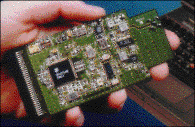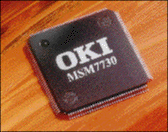Wireless ICs promote faster and lower-cost WLANs
A new generation of wireless LAN (WLAN) chips is aimed at removing the performance and cost barriers currently limiting the development of wireless data equipment. Developed for IEEE 802.11-compliant applications in the 2.4-GHz ISM band, these devices provide the baseband processing and IF/RF circuitry required in a direct-sequence or frequency-hopping spread-spectrum radio.
The direct-sequence architecture is being used by one chip vendor to push the data throughput of WLANs beyond 2 Mbits/s, while other manufacturers have chosen the frequency-hopping approach to lower cost and increase integration–critical factors in PC Card designs. Optimized for battery power, these WLAN chips typically operate from 3-V supplies.
Harris Semiconductor (Melbourne, FL) is breaking the 2-Mbit/s barrier with its introduction of an 11-Mbit/s baseband processor (see Fig. 1 ). The HFA3860 provides all of the transmit and receive functions required for a direct-sequence WLAN radio with performance comparable to 10-Mbit/s wired Ethernet.

Fig. 1. Harris Semiconductor's HFA3860,
an 11-Mbit/s baseband processor, increases
the throughput of the company's PRISM
chipset to produce WLAN designs with Ethernet speed.
An addition to the PRISM WLAN chipset, the HFA3860 offers an upgrade in speed for designs using the chipset's existing 2-Mbit/s processor, the HFA3824. Operating at 11 Mbits/s, PRISM provides 100 to 200 ft of in-building transmission range –approximately half that of a 2-Mbit/s system. However, coverage can be extended by lowering the data rate to 5.5, 2, or 1 Mbits/s.
The current chipset complies with the IEEE 802.11 specification that governs 1 to 2-Mbit/s wireless communications. The HFA3860 is designed to ensure that PRISM meets a revised version of the standard–to be passed later this year–that covers higher-speed operation.
In its current form, the chipset consists of the baseband processor, five IF and RF ICs, and a customer-supplied media access controller (MAC). However, Harris has announced plans to further integrate the chipset by replacing five of the chips with two SiGe devices and by introducing a software MAC. The resulting four-chip solution should be available by the fall of this year.
Packaged in a 48-pin TQFP, the HFA3860 is priced at $9.92 each in quantities of 10,000 while the complete chipset is priced at less than $50 in production quantities.
From Mitel Semiconductor (Scotts Valley, CA) comes Wave, a WLAN chipset based on a frequency-hopping architecture. According to the company, Wave offers the industry's lowest-cost wireless solution for the ISM band, implementing a PC Card with a PCMCIA interface at half the cost of other currently available solutions. The chipset sells for $25 each in quantities of 1,000.
Wave can be configured as either a standalone node or as an access point with 2-Mbit/s operation. A complete system requires the chipset plus associated software, a VCO, IF and transmit filtering, a transmit/receive switch, program memory, and a power amplifier.
The chipset consists of the WL600 RF transmitter/receiver chip, the WL800 frequency synthesizer, and the WL102 wireless data controller. The WL102 provides those physical layer functions not offered by the WL600/800, and also includes the necessary MAC functions and host interface.
In addition, the company provides a software suite that includes a complete MAC protocol as well as low-level functional routines for customers who wish to develop their own protocol. Chipset packaging is in 48-pin LQFPs ('600), 32-pin TQFPs ('800), and 100- or 144-pin PQFPs ('102).
Philips Semiconductors (Sunnyvale, CA) has introduced a WLAN chipset that is said to offer the industry's highest level of integration. Developed in partnership with Lucent Microelectronics, the four-chip set merges antenna, radio, and baseband functions into an IEEE 802.11-compliant solution intended for PC Card applications. Lucent supplies the associated baseband functions in its WaveLAN chipset.
The chipset consists of the SA1630 quadrature IF transceiver, SA2420 RF transceiver, SA2410 power amplifier, and the previously released UMA1021 synthesizer. The devices support both direct-sequence and frequency-hopping architectures.
The power amplifier is a GaAs device that includes a transmit/receive switch on chip and comes packaged in a 32-pin LQFP. The BiCMOS RF transceiver integrates a low-noise amplifier, receive and transmit mixers, and an LO buffer in a 24-pin TSSOP.
The IF transceiver provides an up-and-down mixer driven by a common local oscillator and comes packaged in a 48-pin LQFP. Packaging for the synthesizer is a 20-pin SSOP. The chipset is priced at approximately $20 each in quantities of 100,000.
Oki Semiconductor (Sunnyvale, CA) has introduced a WLAN baseband controller that embeds a frequency-hopping modem (see Fig. 2 ). According to the company, the MSM7730 is the first IEEE 802.11-compliant controller to sell for under $20.

Fig. 2. The MSM7730 baseband controller
from Oki Semiconductor is a low-cost
frequency-hopping radio modem, with an
external modem port that permits use
of direct-sequence or infrared modulation.
The chip provides all necessary functions to support a WLAN card in conjunction with a radio, a processor, and buffer memory. The MSM7730 is designed for both stations and access points, while also supporting the PCMCIA interface with 16-bit data transfers.
The device's on-chip modem provides 1- and 2-Mbit/s operation, while an external modem port allows connection of modems for direct sequence, infrared, and higher-speed PHYs. For power management, there are two modes of low-power operation that reduce current consumption to 3 mA.
The controller's processor interface supports 80C86 and 80C186 processors as well as the V30 and V53. The MSM7730 is available in a 144-pin TQFP and is priced at $19.75 each in quantities of 10,000.
–David Morrison
For more information on the products described in this article contact:
Harris Semiconductor
Melbourne, FL
Information 800-4-HARRIS
http://www.semi.harris.comMitel Semiconductor
Scotts Valley, CA
Brent Wilkins 408-439-6049
http://www.semicon.mitel.comOki Semiconductor
Sunnyvale, CA
Literature 800-OKI-6388
http://www.okisemi.comPhilips Semiconductors
Sunnyvale, CA
Information 800-447-1500, ext. 1514
http://www.semiconductors.philips.com
Advertisement





